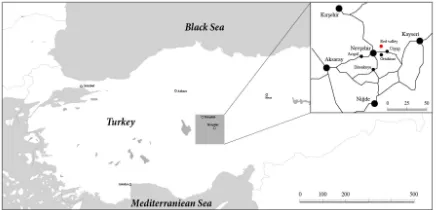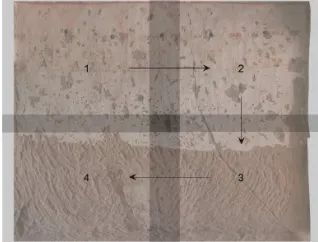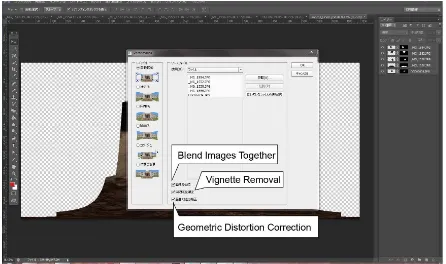METHODOLOGY OF HIGH-RESOLUTION PHOTOGRAPHY
FOR MURAL CONDITION DATABESE
R. Higuchi a, *, T. Suzuki b, M. Shibata c, Y. Taniguchi d
a
Dept. of Built Environment, Tokyo Institute of Technology, Japan - [email protected] b
Asia-Japan Research Center, Kokushikan University, Japan - [email protected] c
National Research Institute for Cultural Properties, Japan - [email protected] d
Graduate School of Humanities and Social Sciences, University of Tsukuba, Japan - [email protected]
Symposium Topic D, D-4 Technologies aimed at preventive maintenance and monitoring of sites
KEY WORDS: Photography, documentation, high-resolution image, mural painting, rock-hewn church, Cappadocia
ABSTRACT:
Digital documentation is one of the most useful techniques to record the condition of cultural heritage. Recently, high-resolution images become increasingly useful because it is possible to show general views of mural paintings and also detailed mural conditions in a single image. As mural paintings are damaged by environmental stresses, it is necessary to record the details of painting condition on high-resolution base maps. Unfortunately, the cost of high-resolution photography and the difficulty of operating its instruments and software have commonly been an impediment for researchers and conservators. However, the recent development of graphic software makes its operation simpler and less expensive. In this paper, we suggest a new approach to make digital heritage inventories without special instruments, based on our recent our research project in Üzümlü church in Cappadocia, Turkey. This method enables us to achieve a high-resolution image database with low costs, short time, and limited human resources.
* Corresponding author
1. INTRODUCTION
Digital documentation, such as high-resolution photography, is one of the cutting-edge techniques and most useful methods to record the condition of cultural heritage. Especially, in recent mural painting conservation projects, high-resolution images become useful because it is possible to show both general view of mural painting and detailed mural condition in a single image. Such digital archiving is necessary because the mural paintings are damaged by diverse mechanisms, such as physical, environmental and biological effects. Therefore, it is necessary to record the details of painting condition on high-resolution base maps.
On the other hand, the cost of high-resolution photography and the difficulty of operating its instruments and software have commonly been an impediment for researchers and conservators. However, the recent development of graphic software makes its operation simpler and less expensive. In this paper, we suggest a new approach to develop a mural painting database, which is based on our recent our research project in Üzümlü church in Cappadocia, Turkey.
2. GENERAL INFORMATION OF ÜZÜMLÜ CHURCH 2.1 Location of the Site and its Architectural Style
The rock-hewn church of Üzümlü (Üzümlü means grape in Turkish) is located in the Red Valley in the Cappadocia in Turkey (Fig. 1). It is close to the west of Ortahisar village. The church shows obvious deterioration phenomena caused by environment, rock composition and seismic activity, biological and human activities including vandalism.
Figure 1. Map of Turkey and around the site
The Üzümlü church is identified as the chapel of Niketas the Stylite (Rodley 1963). Little is known about the history of the church since little documentation exists. However, because the mural paintings are similar to those found in Pantokrator Monastery (Zeyreki Kilise Camii, 1120 - 1136), Istanbul, the mural paintings in the Üzümlü church may date between the periods of the Komnenos dynasty (1081-1185). On the other hand, it is very difficult to determine the exact period when this church was built or when the murals were painted because the cave church was extended by excavating the rock gradually. The mural paintings do not contain any botanical materials such as thatch; therefore, a precise dating is very difficult.
chambers and these two are not covered with mural paintings. The plans of narthex and nave are imperfect rectangles, and the plan of apse is an ellipse. The ceiling of the narthex and nave are barrel vault and that of apse is dome. The two chambers on the north side of nave and apse are cuboid and were never covered with paintings. Compared with the exposed rock surface of the main chambers, the surfaces of the two chambers are roughly excavated. This obviously may indicate that the main chambers and other combers were made by different techniques. Therefore, it would seem that the latter two chambers were never painted. Also, these seem to be excavated in a later period.
Figure 2. Plan of the Üzümlü church
2.2 Former documentation project
The comprehensive documentation of the rock-hewn churches in Cappadocia was first undertaken by Dr. Nicole Thierry, from the University of Paris-Sorbonne, France, in the 1960s (Thierry, 1963). Her research focused on recording the iconographic scheme. Preliminary measurement of the rock-hewn churches around Cappadocia valley was also done by a research team led by Dr. Masaru Maeno, Professor of Tokyo University of the Arts in the early 1970s, during which the architectural drawings of Üzümlü church were made (unpublished). However, since survive on the following surfaces of the church: intrados of the arched entrance, west-wall, south-wall, east-wall, north arch and barrel vaulted ceiling in the narthex, west-wall, south-wall, east-wall and barrel vaulted ceiling in the nave, southeast-east-wall and domed ceiling in the apse, and transverse arch between narthex and apse. Although we assume that the intrados of transverse arch between narthex and nave may be covered with paintings, we cannot identify any remnants of the mural paintings because the lower part of this transverse arch is collapsed.
3. DOCUMENTATION METHODOLOGY Since the paintings are depicted on the large surface of the walls, vaulted ceiling and dome, it was impossible to capture whole images in a single shot. Therefore, the wall was photographed in several pieces both vertically and horizontally, and the pieces
were merged digitally into a single high-resolution image using Adobe Photoshop® software. After the images were rectified by measurement data, each image piece of wall or ceiling was used as base map. The conditions of the mural paintings were recorded on the OHP films on the printed base map. After digitalising the OHP films, the condition of the mural paintings were drawn on the high-resolution base map used by Adobe Illustrator®. Consequently, the process of documentation generally followed these four steps:
1) Photography of the paintings
2) Measurement of the cave and location of paintings
3) Image processing: Merging photographs into a single high-resolution photograph, rectification of the images and creation of the base map.
4) Condition assessment and recording
3.1 Instrument
The instruments we used in our study are listed below: Digital Camera (Canon EOS 60D)
Wide-angle Lens (Canon EF-S10-22mm F 3.5-4.5 USM) Tripod (Manfrotto 055 CXPRO3JP)
Laser digital distance meter (Leica Disto D210) Measuring Tape
Software: Adobe Photoshop CS6, Adobe Illustrator CS6
3.2 Photography of mural painting
Photography was conducted by setting the camera on a tripod horizontally and parallel to the mural painting. Then, the distance between the lens and the mural painting was measured by a digital distance meter. Depending on the dimensions of the mural paintings, the paintings were taken in several shots. When the camera was moved horizontally or vertically, the distance between the lens and the paintings was kept constant, and each shot should contain enough overlap with photographs of adjacent areas, so that the digital merge could be processed successfully. Figure 3 is an example of a merged photograph. In this example, four photos (two rows of two shots) were taken of the wall paining on the south-wall in the nave.
Figure 3. Concept of image merging (the south wall in the nave)
3.3 Measurement
tape. Additionally, the distance between distinctive figures in the mural paintings, such as saints, was measured. When we measured curved surfaces, such as barrel vault or dome, we also measured the inner radial of these in order to make a planar image from the curved surface (Fig. 4).
Figure 4. Diagram of conversion from curved surface to planar image
3.4 Image Processing
The photographs were merged into a single high-resolution image using the "photo merge" function of Adobe Photoshop CS6. The merged image was manually rectified based on the measurement data, and resized to the exact scale. Then, these images were imported into Adobe Illustrator CS6 to record the mural condition. The process of merge and rectification using Adobe Photoshop CS6 is as follows:
[Procedure of Photomerge]
1) Read files (Fig. 5): read the files to merge. Then select [Automate] in the [File] menu. Then click [Photomerge] and Select [Add Open Files].
Figure 5. Image merging process 1: "Photomerge" on the menu
2) Merge files (Fig. 6): check [Blend Images Together], [Vignette Removal] and [Geometric Distortion Correction]. Then click [OK].
3) Check the edge of each of the images (Fig. 7): if the processes above were done correctly, we then check each end of the reading photographs.
4) Combine the layers: select [Layer] menu and click [Merge Visible].
5) Set the guidelines for revision: select [View] menu and click [New Guide...]. Then move the guides based on the measured places such as Figure 8.
Figure 6. Image merging process 2: Choose the files to combine
Figure 7. Image merging process 3: Example of succeeded (left) and failed (right) combining photos
Figure 8. Image merging process 5: Set the guildelines
6) Revise the photograph (Fig. 9): select [Edit] menu and click [Warp] from the [Transform] menu, and revise the distorted areas of the merged photographs and adjust them to fit the exact scale.
Figure 9. Image merging process 6: Chose "Warp" tool
7) Apply the transform (Fig. 10): after finishing transform, click [Apply] in the window "Apply the transform?"
Following this method, we created thirteen base maps.
Figure 10. Image merging process 7: Applying the "Warp" tool
Figure 11. Finished photograph merged five images
3.5 Condition assessment and recording of mural paintings After creating the base maps, the conditions of the mural paintings were recorded on the OHP sheets on the printed base maps. The mural paintings in the Üzümlü church are composed of three layers: rock layer, plaster layer and paint layer. Therefore, we recorded the condition of each layer of a mural painting as separated mural condition sheets. The identified deterioration items in each layer are as follows.
a) Rock layer deterioration is identified by four items: biological activity (Fig. 12-a), deposition of dark material (Fig. 12-b), structural cracks (Fig. 12-c) and spalling (Fig. 12-d). Biological activity is evidence of animal inhabitation on rock, such as insects or spiders. Deposition of dark material is deposit of dark brown or blockish material on the surface of the rock. Structural cracks are large cracks that run through the body of the rock, caused by faulting. Spalling is detachment of the rock on a small scale, in parallel to the surface of the rock.
b) Plaster layer deterioration is identified by five items: detachment of lower plaster layer (Fig. 13-a), mechanical damage (Fig. 13-b), cracking (Fig. 13-c), holes (Fig. 13-d) and incised graffiti (Fig. 13-e). Detachment of lower plaster layer is loss of adhesion between the lower plaster layer and rock substrate, as assessed by visual evidence alone. Mechanical damage is rupture of the painting stratigraphy by human or animal action, causing a variety of damage types: loss of the entire stratigraphy, revealing the underlying rock substrate; loss of the paint layer, ground and part of the lower plaster layer, leaving the interior of the lower plaster layer exposed; loss of only the upper plaster ground, leaving the surface of the lower plaster layer intact; deformation of the painting stratigraphy, which otherwise remain intact. Cracking is that of plaster layer most often
resulting from cracking of the rock structure and mechanical damage, though there may be other causes. Holes are very circular, small holes of approximately 5mm Ø, which enter into the plaster layer and generally do not reach the substrate. Incised graffiti is inscriptions and drawing incised into the surface of the painting, affecting the paint layer, ground and plaster layer.
a. Biological activity b. Deposition of dark material
c. Structural cracking d. Spalling Figure 12. Photos of rock layer deterioration
c. Cracking d. Holes e. Incised graffiti Figure 13. Photos of plaster layer deterioration
c) Paint layer deterioration is identified by ten items: smearing (Fig. 14-a), surface deposition (Fig. 14-b), dark grey veil (Fig. c), micro-losses (Fig. d), grey spotting (Fig. 14-e), original fixing (Fig. 14-f), biological deterioration (Fig. 14-g), superficial graffiti (Fig. 14-h), nail (Fig. 14-i) and paint loss due to biological activity (Fig. 14-j). Smearing is displacement of the paint layer by mechanical action beyond its original location, seen as a spreading of the paint across the surface of the plaster. Surface deposition is deposition of material on the surface of the painting, such as mud from birds' nests or from later construction in the church such as mud plaster. Dark gray veil is veil extending over the surface of the painting, dark gray in color, somewhat patchy, and of unclear origin. Micro losses are extremely small,
a. Detachment of lower plaster layer
rounded losses of the paint layer generally on the order of 0.5-1 mm Ø. Grey spotting is the faint, circular grey spots, 0.5-3 mm Ø, on the surface of the painting. Original fixing is the trace of fixing that may be carried out almost at the same period of mural painting depicted because the colors of this part and around area of that are almost the same. Biological deterioration is discoloration, generally dark gray, of certain areas of painting due to animal inhabitation. Superficial graffiti is the graffiti applied to the surface of the painting using a medium such as paint, ink or graphite. Nail is the part of nail on the paint layer. Paint layer loss due to biological activity is loss of the paint layer due to the former presence of birds' nests primarily which, when separated from the painting surface, removed part of the paint layer.
a. Smearing b. Surface deposition
c. Dark grey veil d. Micro-losses
e. Grey spotting f. Original fixing
g. biological deterioration h. Superficial graffiti
i. Nail j. Paint loss due to biological activity Figure 14. Photos of paint layer deterioration
After recording the condition of deterioration of a layer, the OHP sheet was scanned in order to make digital mural condition sheets (Fig. 15). In the case that there were too many items to record an OHP sheet, we used more than two OHP sheets to record one layer. Using Adobe Illustrator, we traced the scanned data with a pen tool. The traced deterioration places were divided into different layers by each item of deterioration. Therefore, one mural condition sheet can show the deteriorated places of selected items in one layer. Then, the scale of mural condition sheets was adjusted to 1/10, 1/15, 1/20, 1/25. As we checked the deterioration of each layer of the mural paintings, we produced 39 mural condition sheets and 13 photographs of mural paintings for the digital heritage inventories. Figure 15 is one of the examples of digital heritage inventories, which is the paint layer deterioration of the ceiling in the nave.
Figure 15. Scanned OHP sheet of plaster deterioration of the ceiling in the narthex
4. CONCLUSION
In this paper, we suggested a new approach to develop a mural painting database, using normal digital single-lens reflex camera and tripod, measuring tools and standard digital image processing software. Compared with conventional digital documentation, our method can produce high-resolution images at low cost, and with limited time and human resources.
ACKNOWLEDGEMENTS
This work was supported by JSPS KAKENHI Grant-in-Aid for young Scientists (B) Number 24760528.
REFERENCES
Rodley, L., 1985, Cave Monasteries of Byzantine Cappadocia, Cambridge University Press, Cambridge: New York.
Thierry, N. et al., 1963. Nouvelles églises rupestres de Cappadoce, région du Hasan Dagi : new rock-cut churches of Cappadocia, Klincksieck, Paris.




